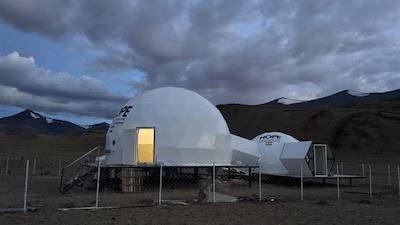
ISRO sets up station in Ladakh to simulate life on Moon & Mars
The Indian Space Research Organisation (ISRO) has taken a significant step towards exploring the possibilities of human settlement on the Moon and Mars by setting up a unique facility in the Himalayas. The Himalayan Outpost for Planetary Exploration (HOPE) has been established in the Tso Kar Valley of Ladakh, a region that is eerily similar to the Martian environment. This facility will simulate life on the lunar and Martian surfaces, testing critical life-support systems that will be essential for future missions.
Located at an altitude of 15,000 feet, the Tso Kar Valley is characterized by high UV radiation, low atmospheric pressure, extreme cold, and saline permafrost – all of which are similar to the conditions found on Mars. This makes it an ideal location for ISRO to conduct experiments and test equipment that will be used in future space missions.
The HOPE facility will be operational for a period of 10 days, from August 1-10, during which two crew members will conduct various tests and experiments. The crew will be equipped with specialized clothing, including space suits, and will have to endure the harsh conditions of the valley to simulate the challenges they will face on the Moon and Mars.
The primary objective of the HOPE mission is to test the life-support systems that will be required for long-duration space missions. This includes the ability to grow food, recycle air and water, and maintain a stable living environment. The crew will also test communication systems, navigation equipment, and emergency response plans.
Speaking about the HOPE mission, ISRO officials said, “The Tso Kar Valley is an ideal location to simulate the Martian environment. The high UV radiation, low atmospheric pressure, and extreme cold will help us test the equipment and systems that will be used in future space missions.”
The HOPE facility is equipped with state-of-the-art equipment, including greenhouses, life-support systems, and communication networks. The crew will have to work in shifts, conducting experiments and tests during the day and night. The facility is also equipped with emergency response systems, including medical facilities and communication equipment.
The HOPE mission is a significant step forward for ISRO’s plans to send humans to the Moon and Mars in the near future. The organization has been working on developing the necessary technologies and infrastructure to support long-duration space missions, and the HOPE facility is an important part of that process.
In the coming years, ISRO plans to send astronauts to the Moon and Mars as part of its manned space program. The HOPE mission is a critical step towards achieving that goal, as it will help the organization test the life-support systems and equipment that will be required for these missions.
The HOPE facility is not just a testing ground for ISRO’s space missions; it is also a unique opportunity for scientists and researchers to study the effects of high-altitude, high-UV radiation environments on the human body. The data collected during the mission will help scientists understand the effects of space travel on the human body and develop strategies to mitigate those effects.
In conclusion, the HOPE mission is a significant milestone in ISRO’s plans to explore the Moon and Mars. The facility in the Tso Kar Valley of Ladakh will play a critical role in testing the life-support systems and equipment that will be required for future space missions. The mission is a testament to India’s commitment to space exploration and its ability to push the boundaries of what is possible.






